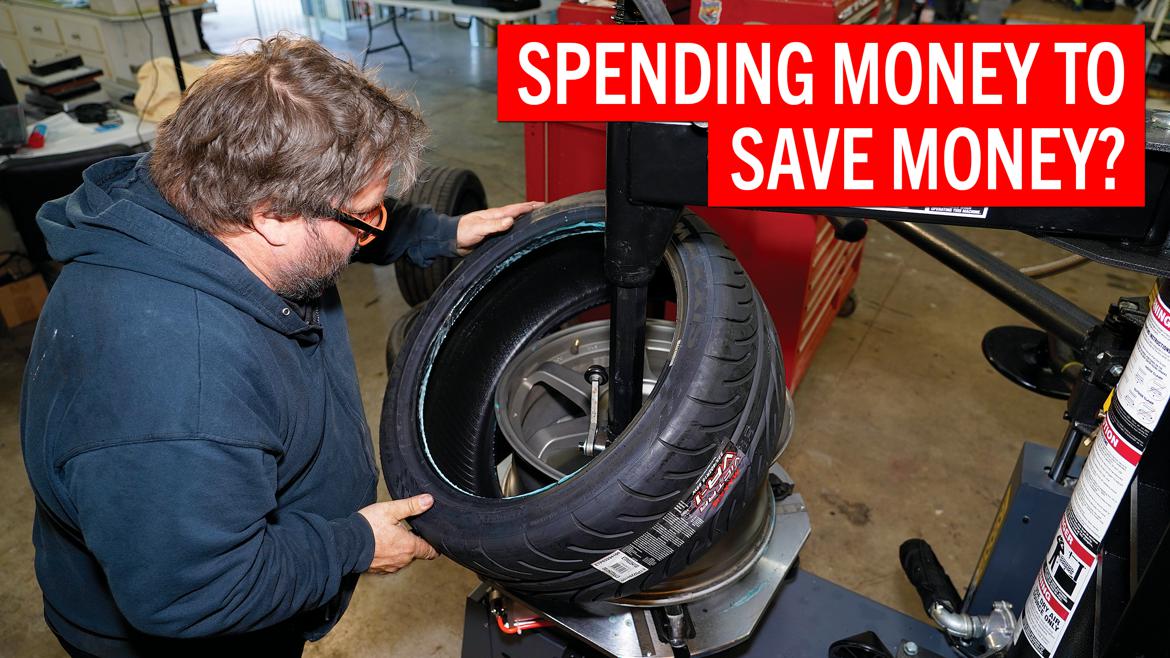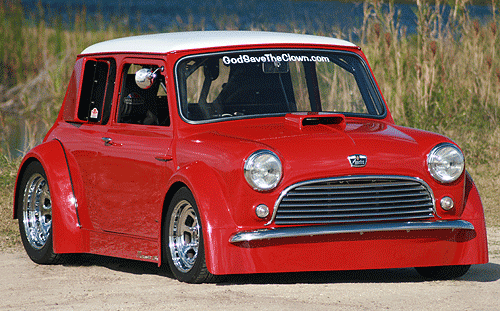Building a car from scratch—from the wheels up—is not for the faint of heart. Still, some people relish the challenge. They find inspiration in that blank sheet of paper. To them, there’s nothing better than saying “to hell with the rules” and bolting together whatever parts make …
Don’t Call It Cute
Kimini is a Mini in name only. Despite the classic envelope, the only parts that came from an assembly line somewhere in England are the doors and windshield. Even the body-side hinges that secure those doors were custom made by Kurt.
Like all classic Minis, the car is diminutive. From a distance, it looks almost normal—tidy, square and well proportioned. But the massive flares, wide tires and hood scoop push it out of the realm of “cute” and give it a purposeful, mean look.
Kurt built almost everything on the car, and his engineering training served him well. The suspension, for example, is straight out of good race car design books—inboard shocks are used at both ends of the car. The fronts are actuated by bellcranks running from the hand-fabricated front A-arms, while the rears are mounted directly to the uprights.
All told, Kimini represents more than 10 years of Kurt’s weekends and holidays. As he explains, he always wanted to build his own car. However, he was never completely satisfied with any of the commercially available kit cars.
[Turn a pile of tubes into your own creation | Scratch-built solutions: Part 1]
Kurt’s plans started moving in 1995 thanks to a chance discussion with a co-worker who was into kit cars. The co-worker just happened to be selling a carbon-fiber bodyshell copied from an original Mini. It fit the bill perfectly, as Kurt wanted to build something that was small and light for strong performance yet had a full body for practicality.
“The fact that I got the shell early on dictated the whole thing after that,” Kurt says. “The guy was building it to be an autocross car, and it was designed for a front-wheel drive powertrain and an enormous venturi.”
The original builder gave up on the autocross terror before doing much more than molding the shell, but Kurt saw the potential in the forlorn project. He decided that it would make the perfect basis for his dream car project.
The first major design decision was the engine type and placement. Kurt wanted the car to be mid-engined for the best possible handling—that part was easy—but deciding which powerplant to use took some thinking.
Thanks to its sophisticated design and large capacity, Kurt eventually settled on a Honda H22 engine from a mid-’90s Prelude. He considered other Honda twin-cams, but ultimately decided on the H22 because it displaced 2.2 liters and would provide astounding performance in stock form.
[Old-School Reviews | 1997 Honda Prelude, VW GTI and Chrysler Town & Country]

From a distance, this Honda-powered beast may look like a Mini, but step closer and you’ll quickly see that it’s a custom-built monster. Coil-over dampers flank the mid-mounted Honda VTEC mill to keep it as tight to the road as possible .
“In 1995 and 1996, the Prelude engine was the engine to have,” he says. “I wanted something with torque that would be plenty fast right out of the box, but at the time I didn’t know how much the engine weighed.”
He took a chance and ordered the then-expensive engine, but it turned out to weigh about 100 pounds more than he was expecting: “Now I know it’s 475 pounds, complete with transmission, but there was no way to know before I got it.”
The only deviations from standard are the linkages, Quaife limited-slip differential, aluminum flywheel, plumbing and a trick, handmade exhaust header that shaves precious pounds off the car. Everything else remains just as Honda intended it, all in the name of reliability.
[What's the Diff? | Figuring Out Which Differential Setup Is Fastest on Track]
Stock it may be, but the engine has also proved to be powerful enough to give the lightweight car astounding acceleration—zero-to-60 mph times are in the sub-4-second range.
Mix-and-Match Suspension
The Kimini’s underpinnings are a mixture of custom fabricated parts, like all the suspension links, and production car parts, like the Triumph Spitfire steering rack and Nissan front hubs. Everything was assembled with an uncommon attention to detail. That would make a professional touring car builder proud.
“I used the front uprights and brakes from a mid-1980s Nissan 280ZX,” Kurt says, “because I liked the idea of using cut-down struts for the upper pivot in a dual A-arm front suspension. It seemed like a neat idea and it worked well.”

With large chunks of the carbon fiber shell removed, the Kimini looks less like a Mini and more like what it really is: a tube-frame creation built for speed.
The rear uprights are fabricated, but they use the original Honda Prelude discs. “The Honda calipers were big and heavy, so I walked around the junkyard looking for a pair that were lighter and settled for some off of an ’86 RX-7.”
The suspension was designed from the outset around 13-inch tires, which were considered state-of-the-art at the time. The size is not so common today, although it’s probably the only compromise found in the suspension design.
[10 Common Suspension Problems and How to Cure Them]
“I designed the front suspension to have no bumpsteer throughout its range of motion, but in the rear, it has dynamic toe change,” Kurt explains. “When I designed it, I had the idea that it would be good to have toe-in on both droop and compression.”
Carbon-Fiber All the Way
While the car looks like a classic Mini at first glance, the shell is just as trick as the chassis. Each end of the car can be removed for access to the suspension, brakes and so on. Cool details abound, like the aluminum undertray, plastic rear window and carbon-sandwich instrument panel.
As Kurt recalls, the body’s only steel panels were one of the hardest parts of the project. “The doors were an annoying, fiddly part of the job,” he explains. “They were a real pain to fit right.”

A pair of Cobra seats means owner Kurt Bilinski can share the fun of a mid-mounted engine with a friend.
Kurt eventually won the battle, but the body put up a tough fight. “I bought a donor basket-case for the doors, but one fell apart from rust so I had to source another one. On one side, I had to cut down the whole window frame to get it to fit, even though the body was taken right off of a real Mini.”
When it came time to paint the car, Kurt had to plan ahead. “I went with silver because I didn’t want the car to look too cartoonish.”
The light color has another benefit. “It also helps with keeping the carbon fiber body straight because it reflects heat,” he explains. “The epoxy resin in the carbon composite gets soft above 140 degrees, which would be easy to hit with a dark color out at Willow Springs.”
And a Little Dose of Reality
Although Kurt hoped to commute with the Kimini at least once in a while, the reality of Southern California’s traffic and heat has dampened his enthusiasm somewhat. Remember, this is basically a street-legal, prototype racer.
“Unfortunately, I had hoped to drive it more, but without a/c, it’s no fun to drive in the heat and humidity. Also, I know it sounds like whining, but the manual transmission makes it a chore to drive in traffic. However, driving it on open roads is an absolute blast.”
The Kimini was such a huge undertaking that Kurt decided to put all of his notes, build diaries, plans and thoughts down on paper. In fact, later this year he will publish a book on the project.
Now that Kurt’s Kimini is complete, the question he hears most often is, “What’s next?” While his next automotive endeavor is still undecided, Kurt knows exactly what is coming up: “My next project is a home remodel, which I am dreading,” he says.

The car’s silver paint helps prevent carbon fiber warping from sun exposure as the temperature rises.
But that’s not to say that he has no plans for another home-built car. Whatever he builds, Kurt is convinced that more simplicity is key. “The next thing I build will be something without doors because I don’t want to mess around with them again. Also, for lots of reasons I have an urge to build a three-wheeler. Something like a three-wheeled Ariel Atom.”
Whatever he decides, you can be sure that the end product will be as detailed as the jewel-like Kimini and just as uncompromising in execution.


























